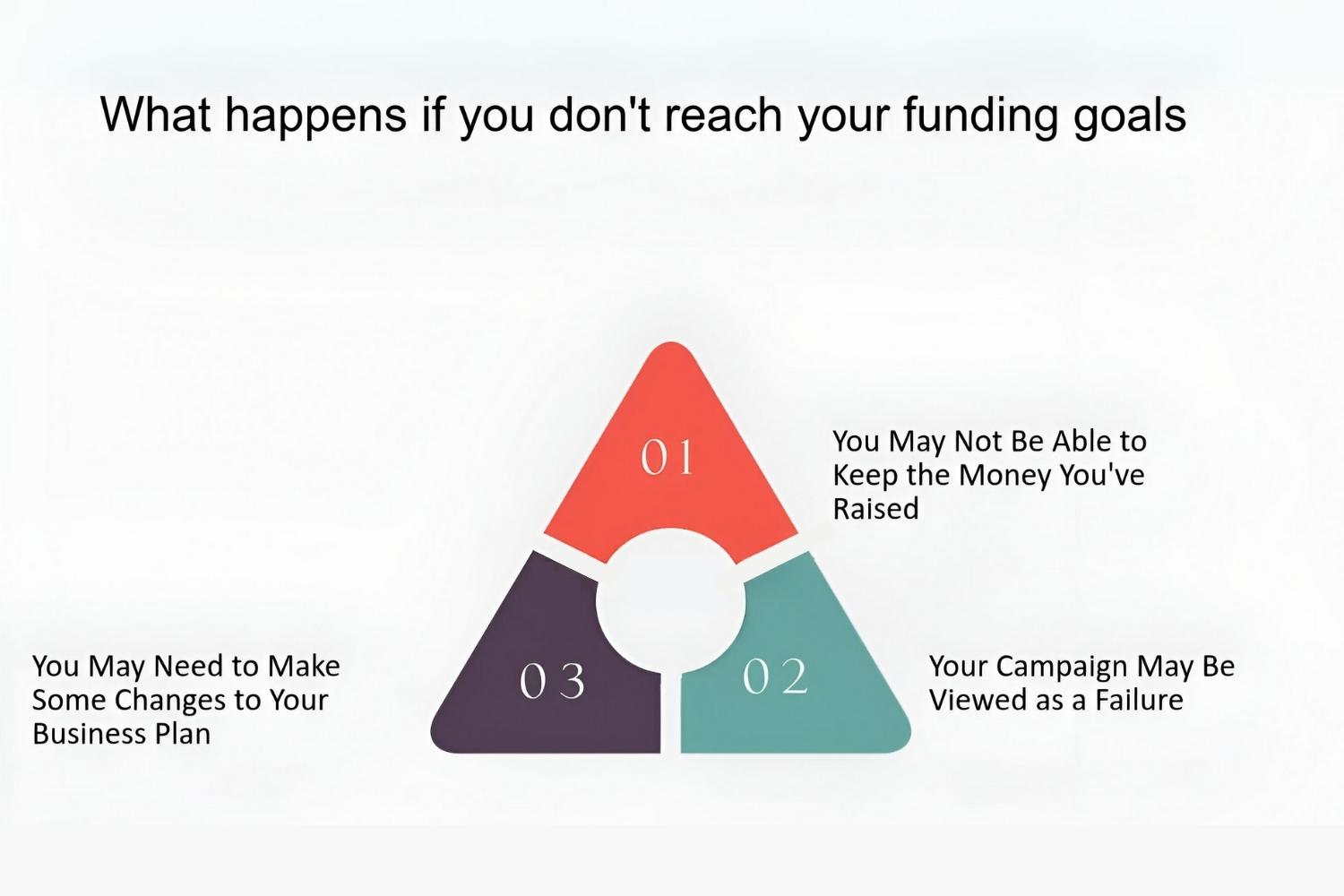The Impact of Not Reaching the Funding Goal
Running a crowdfunding campaign requires careful planning, hard work, and a sprinkling of luck. While every campaign hopes to surpass their funding goal, it’s not uncommon for projects to fall short. When a crowdfunding campaign doesn’t reach its target, it can have various impacts on both the project creators and the backers.
First and foremost, not reaching the funding goal means that the project is not able to proceed as originally envisioned. This can be disheartening for the creators who have poured their time, energy, and resources into developing their idea. It can be demotivating to see a project you believe in fall short of its financial backing.
From a backer’s perspective, not reaching the funding goal may result in disappointment. Backers who pledged their support and had high expectations for the project may feel let down when it doesn’t come to fruition. There may be a sense of frustration or a loss of trust in the campaign creators.
Additionally, not meeting the funding goal can have financial implications. The creators may have invested their own money into the project or taken out loans, with the expectation that the campaign would be successful. When the goal is not met, these financial commitments can become burdensome.
Furthermore, failing to reach the funding goal can damage the reputation of the project and its creators. The perception that the campaign was unsuccessful may deter potential partners, investors, or customers from getting involved in the future. It can be challenging to recover from a failed crowdfunding campaign and regain momentum.
Moreover, there may be emotional and psychological effects on the creators. They may feel a setback in their confidence, questioning their abilities and the viability of their project. It can be mentally draining to deal with the emotions associated with the failure of a crowdfunding campaign.
On a positive note, not reaching the funding goal can also serve as a learning experience. It provides an opportunity for the creators to reflect on what went wrong and identify areas for improvement. It can help them refine their project, reassess their marketing strategy, and better understand the needs and preferences of their target audience.
In summary, failing to reach the funding goal in a crowdfunding campaign can have various impacts on the project creators, backers, and the overall project itself. From financial implications to reputational damage, it’s important for creators to address these effects and adapt their approach for future endeavors.
Possible Reasons for Falling Short
When a crowdfunding campaign doesn’t reach its funding goal, it’s crucial to analyze the reasons behind the shortfall. Understanding these reasons can help project creators identify areas for improvement and prevent similar mistakes in the future. While each campaign is unique, here are some common factors that can contribute to falling short:
- Lack of exposure and visibility: One of the primary reasons for not reaching the funding goal is a lack of sufficient exposure. If the campaign fails to generate enough buzz and reach a wide audience, it’s unlikely to attract the necessary number of backers. Insufficient marketing efforts, limited audience targeting, or ineffective promotion strategies can all contribute to low visibility.
- Inadequate planning and preparation: A poorly executed campaign due to inadequate planning and preparation can hinder its success. When creators fail to set realistic funding goals, establish a solid timeline, or craft a compelling campaign message, it can result in a lackluster response from potential backers. Lack of preparation can also lead to logistical issues in delivering rewards or managing backer expectations, further impacting the campaign’s outcome.
- Weak value proposition: Backers need to be convinced that their contribution will result in a meaningful and worthwhile outcome. If the project’s value proposition is not clearly communicated or lacks uniqueness, it can fail to inspire backers to pledge their support. Creators should articulate the project’s vision, benefits, and potential impact to highlight its value and differentiate it from competing campaigns.
- Unrealistic funding goals: Setting unrealistic funding goals can discourage potential backers from participating. If the target amount seems unattainable or the campaign lacks a clear budget breakdown, backers may be hesitant to contribute. It’s essential for creators to conduct thorough research and carefully calculate the funds required to successfully execute their project, setting a realistic funding goal that aligns with their needs.
- Lack of trust and credibility: Building trust with potential backers is vital for a successful crowdfunding campaign. If creators have a limited online presence, lack previous project experience, or fail to provide detailed information about themselves and their team, it can raise red flags and lead to a lack of trust. Backers want to feel confident that their money is being entrusted to capable and trustworthy individuals.
In summary, falling short of the funding goal in a crowdfunding campaign can stem from a variety of factors. Lack of exposure, poor planning, weak value proposition, unrealistic funding goals, and a lack of trust and credibility are all potential causes. By addressing these issues, project creators can increase their chances of running successful campaigns in the future.
How to Handle Not Meeting the Goal
Not meeting the funding goal in a crowdfunding campaign can feel like a setback, but it’s important to handle the situation gracefully and take proactive steps towards mitigating the impact. Here are some strategies to consider:
- Communicate with backers: Transparency is key when a campaign falls short. Reach out to your backers and explain the situation honestly. Provide updates on the project’s status, reasons for not meeting the goal, and what steps you plan to take moving forward. Keep the lines of communication open and address any concerns or questions raised by your backers.
- Reassess your funding needs: Take a critical look at your project and reassess your funding requirements. Determine if it’s possible to proceed with a reduced budget or if additional funding sources are needed. Be open to adjusting your plans and exploring alternative avenues to bring your project to life.
- Offer alternatives to backers: If your campaign fell short but you still want to deliver a product or service to your backers, consider offering alternative options. This could be a scaled-down version of the original project, a different product or service with similar value, or a refund option for those who prefer it. Providing alternatives shows your commitment to delivering on your promises.
- Learn from the experience: Take the opportunity to learn from your failed campaign. Analyze what worked and what didn’t, and identify areas for improvement. Use the feedback and insights gained to refine your project, marketing strategies, and approach for future crowdfunding endeavors.
- Seek additional funding: If your campaign fell short but you’re still passionate about bringing your project to life, consider exploring other funding options. This could include seeking venture capital, applying for grants or loans, or even launching a new crowdfunding campaign with lessons learned from the previous one. Be proactive in exploring alternative sources of funding to keep your project moving forward.
Remember, not meeting the funding goal does not have to be the end of your project. It’s an opportunity to regroup, reassess, and find new ways to make your vision a reality. By handling the situation professionally, staying connected with your backers, and being open to alternative approaches, you can navigate the challenges and move forward in a positive direction.
Communicating with Backers
When a crowdfunding campaign falls short of its funding goal, effective communication with backers becomes crucial. Transparent and proactive communication can help maintain trust, address concerns, and keep the community engaged. Here are some key strategies for communicating with backers:
- Be honest and transparent: It’s important to be honest about the status of the campaign and the reasons for not meeting the funding goal. Transparency builds trust and demonstrates your commitment to the project. Share updates and provide insight into any challenges or setbacks you encountered along the way.
- Express gratitude: Show appreciation to your backers for their support and belief in your project. Express your gratitude for their contributions, regardless of whether the campaign reached its funding goal. Let them know that their support was valuable and that their backing is still meaningful to you.
- Provide regular updates: Keep your backers informed about the progress of your project, even if it didn’t reach its funding target. Share updates on the development process, any modifications to the project’s scope, and the steps you are taking to move forward. Regular updates will demonstrate your commitment to fulfilling your promises and keeping backers in the loop.
- Address concerns promptly: Some backers may have concerns or questions following the campaign’s shortfall. Respond to their inquiries promptly and address their concerns with empathy and clarity. Assure them that their concerns are valid and that you are taking steps to navigate the situation and deliver a satisfactory outcome.
- Offer alternatives: If the campaign fell short but you still intend to move forward, present alternative solutions or options to your backers. This could include modified versions of the original project, alternate products or services, or the possibility of future campaigns. By providing options, you show your commitment to finding a resolution that aligns with backers’ expectations.
- Show continued dedication: Even if the funding goal wasn’t met, demonstrate your unwavering dedication to the project. Share your passion and vision, and communicate your determination to find alternative means of funding and bring the project to life. Reassure your backers that their support is vital and that you are doing everything possible to overcome the setback.
Communication is key in maintaining a positive relationship with your backers, even in the face of a crowdfunding campaign that falls short. By staying transparent, expressing gratitude, providing updates, addressing concerns promptly, offering alternatives, and showcasing your dedication, you can foster trust, retain support, and navigate the challenges together.
Adjusting Plans for the Future
When a crowdfunding campaign doesn’t meet its funding goal, it’s crucial to adjust your plans and strategies for the future. Learning from the experience and making necessary changes can increase the chances of success in subsequent endeavors. Here are some key considerations when adjusting your plans:
- Reflect on the campaign: Take the time to analyze the crowdfunding campaign that fell short. Identify what worked well and what could have been improved. Review the marketing strategies, messaging, and target audience to gain valuable insights for future campaigns.
- Reassess your goals: Take a step back and reassess your goals for the project. Carefully consider the funding target and whether it was realistic given the nature of the project. Adjust your goals accordingly to ensure they are achievable and align with the project’s needs.
- Refine your value proposition: Identify what sets your project apart and refine your value proposition. Clearly communicate the unique benefits and advantages your project offers to potential backers. Highlight how it solves a problem or meets a need in a distinct way.
- Revise your marketing strategy: Evaluate your marketing efforts during the previous campaign and make necessary adjustments. Explore new marketing channels, improve your messaging, and refine your targeting to reach a wider audience and generate more interest in your project.
- Cultivate a community: Focus on building a community and engaging with potential backers before launching a new crowdfunding campaign. By cultivating a dedicated following and garnering support in advance, you can create a solid foundation of backers who are genuinely interested in your project.
- Consider feedback: Pay attention to feedback received during and after the unsuccessful campaign. Listen to the concerns and suggestions of your backers and potential supporters. Incorporate their insights to make meaningful changes that enhance your project and campaign approach.
- Explore alternative platforms: Consider exploring different crowdfunding platforms or even other funding options. Research and identify platforms that best align with your project and target audience. Additionally, explore alternative funding sources such as grants or partnerships that may be better suited for your project.
- Network and collaborate: Build connections within your industry and explore opportunities for collaboration. Partnering with like-minded individuals or companies can provide additional resources, expertise, and exposure for your project. Collaborations can also bring new perspectives and help expand your reach.
In summary, adjusting your plans for the future after a crowdfunding campaign falls short is crucial for ongoing success. Reflecting on the campaign, reassessing goals, refining your value proposition, revising your marketing strategy, cultivating a community, considering feedback, exploring alternative platforms, and networking can all contribute to a stronger and more successful crowdfunding campaign in the future.
Lessons Learned from Failed Crowdfunding Campaigns
Failed crowdfunding campaigns can be disappointing, but they also provide valuable opportunities for learning and growth. Reflecting on these experiences and extracting meaningful lessons can help you navigate future crowdfunding endeavors with more success. Here are some key lessons to consider:
- Set realistic funding goals: One crucial lesson is to set realistic funding goals for your campaign. Take the time to thoroughly research and calculate the expenses involved in your project. Consider the size of your audience and their willingness to support your idea. Setting attainable goals helps build confidence among backers and increases the chances of reaching and surpassing your target.
- Invest in pre-launch marketing: The success of a crowdfunding campaign largely depends on the initial momentum generated before the launch. Allocate time and resources to build a strong pre-launch marketing strategy. Create anticipation, engage with your target audience through social media, and build an email list of potential backers. A solid pre-launch strategy can make a significant difference in the success of your campaign.
- Craft a compelling campaign story: Your campaign story plays a crucial role in capturing potential backers’ attention and motivating them to support your project. Ensure that your story is well-crafted, engaging, and effectively conveys the purpose and value of your project. Use creative visuals, clear messaging, and relatable storytelling techniques to captivate and connect with your audience.
- Stay engaged with backers: Communication is key throughout the campaign. Regularly update your backers on the progress of your project, even if the campaign doesn’t reach its funding goal. Maintaining open and transparent communication fosters trust and keeps supporters engaged. Collect and address feedback to show that you value their input and are dedicated to delivering a quality project.
- Learn from feedback and failure: Pay close attention to the feedback received during and after your campaign, especially from backers or potential supporters. Analyze what worked well and what didn’t, and apply those insights to improve your future campaigns. Embrace failure as an opportunity to grow and adapt, using it as fuel to refine your strategies and approach.
- Explore diversified funding sources: Relying solely on crowdfunding for funding can be risky. Consider other funding sources such as grants, loans, or partnerships to support your project. Diversifying your funding approach can provide more security and stability, especially if your crowdfunding campaign falls short.
- Build a supportive network: Cultivate relationships within your industry and build a supportive network of professionals, backers, and other creators. Engage in collaborations, attend industry events, and leverage the power of connections to enhance your campaign’s exposure and reach.
By embracing the lessons learned from failed crowdfunding campaigns, you can set yourself up for greater success in future endeavors. Set realistic goals, invest in pre-launch marketing, craft compelling campaign stories, stay engaged with backers, learn from feedback and failure, explore diversified funding sources, and cultivate a supportive network. Remember, each failure is an opportunity to grow and refine your approach, bringing you closer to a successful crowdfunding campaign.
Exploring Alternative Funding Options
When a crowdfunding campaign falls short of its funding goal, it’s essential to explore alternative funding options to bring your project to life. While crowdfunding is a popular and effective method, there are other avenues that may provide the necessary financial resources. Here are some alternative funding options to consider:
- Grants: Research and apply for grants that align with the goals and objectives of your project. There are various grants available from government agencies, non-profit organizations, and foundations that provide funding for innovative and impactful projects.
- Loans: Explore loan options to secure the necessary funds for your project. Consider traditional bank loans, small business loans, or microloans that are specifically designed to support entrepreneurs and small businesses.
- Angel investors and venture capitalists: Seek out potential angel investors or venture capitalists who may be interested in investing in your project. Pitch your idea and demonstrate the potential return on investment to attract their support.
- Corporate partnerships: Explore partnerships with corporations that align with your project’s goals and values. Collaborating with larger companies can provide financial support, resources, and access to a wider audience. Additionally, corporate partnerships bring credibility and expertise to your project.
- Pre-sales and pre-orders: Offer pre-sales or pre-orders of your product or service to generate revenue and fund the development or production process. This approach not only provides a source of funding but also validates market demand for your project.
- Crowdfunding platforms: Consider revisiting crowdfunding platforms and launching a new campaign with revised strategies and goals. Apply the lessons learned from the previous campaign to improve your chances of success. Engage with the crowdfunding community and leverage the power of social sharing to expand your network.
- Bootstrapping: If feasible, consider self-funding your project through personal savings or by generating revenue from other sources. Bootstrapping allows you to maintain complete control over your project and operations but may require careful financial management.
- Earned income and revenue streams: Generate income through alternate revenue streams related to your project. This could include sales of related products or services, licensing agreements, consulting, or speaking engagements. Diversifying your revenue streams can provide the necessary funds to support your project’s development.
Remember, exploring alternative funding options requires careful research, planning, and strategy. Consider the unique needs and requirements of your project, and align your approach with the funding sources that best fit your goals. Be prepared to tailor your pitches and proposals to various funding entities and showcase the potential value and impact of your project.
By being resourceful and considering alternative funding options, you can find alternative pathways to bring your project to fruition, even if the initial crowdfunding campaign didn’t reach its goal.

























